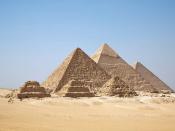When creating the Statuette of Nedjemu, the artist tries to represent the deceased in a manner appropriate for eternity. By using Old Kingdom funerary sculpture conventions, the artist achieves the goal of creating a sculpture suitable for placement in a tomb.
The artist who created the Statuette of Nedjemu is unknown. The artist was from the Old Kingdom, Dynasty V, approximately 2500-2350 BC. Although entitled the Statuette of Nedjemu, the figure portrayed may not actually be Nedjemu.
"This little statuette was probably a quick, "off-the-shelf" purchase after Nedjemu's death." Claims the University of Memphis.
Regardless of who the figure is, the hieroglyphs at the bottom of the base says that the statue was purchased for Nedjemu's tomb by his son.
This work does not have a specific date, however its time period is the Old Kingdom, c. 2500-2350 BC. The Statuette of Nedjemu is a freestanding sculpture in the round.
This sculpture was made out of limestone, a material found in abundance in Egypt.
Although I am unable to find the dimensions of the Statuette, I believe it is little as Statuette implies.
The original location of this limestone sculpture was Giza, in Nedjemu's tomb. This work has since been removed and relocated to The University of Memphis Egyptian Antiquities Museum.
At present, the work is in good condition. Although the Statuette may have been brightly colored at one point, all that remains of color are traces of reddish brown paint on the legs of the Statuette.
The subject of this Old Kingdom sculpture is the King's scribe and messenger, Nedjemu. Nedjemu, meaning "sweet one" was also the overseer of the granaries on the western border of Egypt.
This sculpture is not an event from history or a scene from daily life. This statue is more of...


